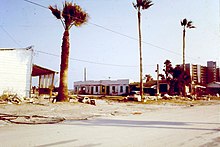Hurricane Allen
An extremely powerful tropical cyclone, Allen affected the Caribbean, eastern and northern Mexico, and South Texas in August 1980.
Allen was an early-season Cape Verde-type hurricane, originating from a tropical wave that left the African coastline on July 30.
[1] Early on August 2, as the depression moved quickly westward towards the Caribbean, it intensified into the first named storm of the 1980 Atlantic hurricane season.
[2][3] Allen continued to move quickly westward and entered the Caribbean Sea shortly after passing south of St. Lucia.
[5] Another reconnaissance aircraft shortly thereafter discovered Allen had become an extremely strong Category 5 hurricane, with sustained winds of 180 mph (290 km/h) and a minimum pressure of 911 mbar (26.9 inHg) the following day.
Allen reached its second and greatest peak intensity on the afternoon of August 7, with maximum sustained winds of 190 mph (305 km/h) and a minimum barometric pressure of 899 mbar (26.5 inHg).
[6] Continuing westward, the southern portion of Allen's circulation passed over the Yucatán Peninsula, causing the cyclone to weaken again.
Pressure falls over the southern United States at this time indicated Allen would soon slow its forward motion as it approached Texas.
[2] Allen's forward speed slowed considerably in the hours before it made landfall near Brownsville as a low-end Category 3 major hurricane on August 10.
[2] As Allen approached the Caribbean Sea, gale warnings and a hurricane watch were issued for the islands of Barbados, St. Lucia, St. Vincent, Dominica, Grenada, Martinique, and Guadeloupe during the daylight hours of August 3.
[8] In addition to the various watches and warnings put in place ahead of Allen's arrival, various international governments took measures to prepare for the hurricane in Haiti.
[10]: 2 Tens of thousands of people evacuated the Texas coast before Allen's landfall, and forecasters advised that all areas within one mile of the coastline be cleared.
[17] The country's banana crop was devastated, and its main hospital, Victoria Hopsital, was left powerless and with part of its roof missing.
[17] Despite being located 250 mi (400 km) away from Allen's center as it passed to the south, Puerto Rico saw wind gusts of up to 70 mph (110 km/h) due to the hurricane.
[18] In the central Caribbean, Cayman Brac was hit by winds in excess of 115 mph (185 km/h) which caused considerable property damage.
Wind speeds of 100 mph (160 km/h) occurred along Jamaica's northern coast where Allen made its closest approach to the island.
In Port-au-Prince, Allen caused many fallen trees, local flooding, and temporary disruptions to electric power and telephone services.
Tropical storm-force winds in Corpus Christi, Texas blew roof gravel through the city, which led to substantial glass breakage to the 18-story Guarantee Bank Building and a 12-story wing of Spohn hospital.
[24] Allen dumped 15 to 20 inches (380 to 510 mm) of rain in south Texas along a 50 to 100 mile swath of land from the coast inland, ending a summer-long drought during the Heat Wave of 1980.
[26] The storm caused seven deaths in Texas and 17 in Louisiana, most in the latter state resulting from the crash of a helicopter evacuating workers from an offshore oil platform.
[15][27] Overall, however, the storm caused less damage than initially feared in the United States due to its suddenly diminished power, as well as its highest tides and winds hitting a sparsely populated portion of the Texas coast.
[15][28] Areas of northeastern Mexico saw heavy rains with the passage of Allen, with the highest totals exceeding 7 inches (180 mm).
[17] In the aftermath of Allen, the United States Department of Defense announced it would be providing aid to St. Lucia, Haiti and Jamaica.
[9]: 3 US helicopters transported a total of 108,123 pounds of relief supplies and 10,793 gallons of water to Haiti; following this, all Department of Defense officials withdrew from the country by August 21.
[9]: 4 Concerns of a potential malaria outbreak due to expanses of standing water led Haiti's anti-malaria office to request the drug chloroquine from the US government.
Josie also called for large investments of capital into rebuilding the severely disrupted shipping industry on the island, as 120 boats had been lost and 32 more damaged.
[31] US President Jimmy Carter declared six counties in southern Texas major disaster areas on August 11, allowing them to receive federal and state financing for cleanup from Allen.
[32] The American Red Cross expected a $2 million expenditure for post-storm relief (as well as to shelter 136,000 evacuees during the storm's climax).
After various tankers were grounded in silt stirred up by the hurricane, the Federal Emergency Management Agency (FEMA) requested the Coast Guard to compile a list of all ships still at sea near southern Texas.

Tropical storm (39–73 mph, 63–118 km/h)
Category 1 (74–95 mph, 119–153 km/h)
Category 2 (96–110 mph, 154–177 km/h)
Category 3 (111–129 mph, 178–208 km/h)
Category 4 (130–156 mph, 209–251 km/h)
Category 5 (≥157 mph, ≥252 km/h)
Unknown


